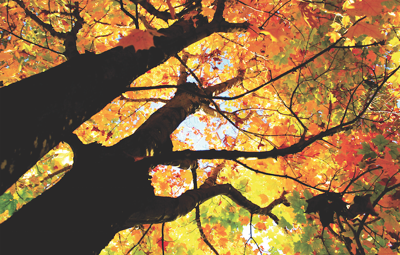As the mornings grow chilly and the days get shorter, people from all walks of life flood Vermont to see the colorful metamorphosis of autumn.
The once-green foliage is slowly taken over by robust reds and yellows, and the leaves begin to die.
Why does this change happen? What’s the science behind fall foliage?
The color change starts as trees get less sun and prepare to go into a kind of hibernation for the winter, said Abby van den Berg, a researcher at UVM Extension’s Proctor Maple Research Center in Underhill.
That causes the leaves to shut down their production of chlorophyll, a green pigment that is instrumental in plants’ food production process, which in turn allows other pigments to show their colors.
The first to show up are the yellow carotenoids, which work in tandem with chlorophyll to nourish the tree all summer.
As chlorophyll production grinds to a halt, the pigments already in the leaves start breaking down, which brings out the yellow color of the carotenoids.
One interesting thing, van den Berg said, is that even though pigments such as chlorophyll and the carotenoids are being broken down, the leaves are producing new pigments.
Does anybody know why that’s happening?
“Nope,” van den Berg said with a chuckle. The pigment in question is called anthocyanin, and it produces the reds and purples of the fall landscape.
Though scientists are not really sure why leaves produce this new pigment, she said they have a few theories:
• The pigment may act as a kind of sunscreen for the leaves.
• It may be a kind of antioxidant.
• It may deter herbivores from making a lunch of the leaves.
But nobody really knows.
“It’s a beautiful process,” van den Berg said. “At least, the nonscientist in me thinks so.”
Peak foliage
Then there’s the question of when.
When people plan their pilgrimages to see the autumnal palette, they want to make sure their trips coincide with peak foliage — the best time to see the most colors on the trees.
Van den Berg said there’s really no scientific way to predict when peak foliage will occur; too many factors go into the color change — environmental and otherwise.
She said it takes years of experience for a person to build up the skills needed to predict peak foliage.
Roger Hill, whose company Weathering Heights does forecast consulting and who writes a weekly weather column for the Stowe Reporter, has spent many years tracking the change in foliage.
Hill said that, as he tries to figure out when peak foliage will occur, the sun has a big role.
The more sun the trees get, the longer it takes for the leaves to change, and once it gets cloudy, the process accelerates.
Looking at the weather going forward, Hill guesses peak foliage will be about Oct. 10.


(0) comments
Welcome to the discussion.
Log In
Keep it clean. Please avoid obscene, vulgar, lewd, racist or sexual language.
PLEASE TURN OFF YOUR CAPS LOCK.
Don't threaten. Threats of harming another person will not be tolerated.
Be truthful. Don't knowingly lie about anyone or anything.
Be nice. No racism, sexism or any sort of -ism that is degrading to another person.
Be proactive. Use the "Report" link on each comment to let us know of abusive posts.
Share with us. We'd love to hear eyewitness accounts, the history behind an article.